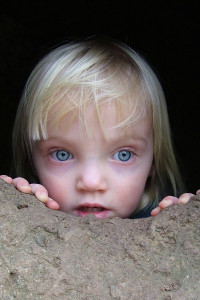 Skepticism is sometimes given a bad rap.
Skepticism is sometimes given a bad rap.
Skeptical doesn’t mean cynical. Raising your kids to be mindful, to question, to apply critical thinking to ideas that are popular in the culture (often undeservedly), will help them become more informed and woo-averse adults. So how do you raise a little Bright?
A DOZEN IDEAS TO TRY:
1. Teach your child to see everything in new ways. When you pass a garden, ask her to imagine seeing it as though she were a mole, from underneath, or from above, as if from an airplane. Paying attention is not about staring at a thing, but about really seeing it. And when your child has the habit of finding the novelty in any situation, she can never be bored.
2. Play “What’s the difference?” In this any-age game, choose an easy route in your neighborhood, even simply around the block. Each time you take the same walk (or the same car pool route), see how many differences you and your child can discover. Has that old tree begun to lose its leaves? Is there a picket missing from Mr. Jones’ fence? Does the Rodriguez family have a new car? In what ways is it different from the old car? In what ways might it be different that we can’t see unless we go inside or underneath it?
3. Show kids how to reflect on their thinking processes. You might ask, for example, how you would divide up eight items among four people. One might move eight cubes around to see how many each person would get, while another might manipulate eight sticks, and a third child would think the problem through in her head. They learn that there are many ways of coming to the same right answer
4. Have your child interact with story characters. One elementary school teacher told me he would point to a picture in a book and ask the children, “What’s his name? What is he doing?” When reading them “The Princess and the Pea,” he’d ask them to write letters to either the Princess, the Prince, or the Princesses who didn’t get picked by the Prince. One child wrote, “Dear Princesses: I’m sorry you didn’t get picked. Maybe there aren’t enough princes. I think you should marry someone your own age.” These youngsters learn that there is more to the story (or any situation) than what is first presented to them, and that they can contribute to the working out of the story. In addition, humor is a great way to break open people’s mind-sets.
5. Draw unusual solutions. Though schools mostly teach how to react analytically to what’s already been suggested, children need to learn to come up with novel ideas. Noted educator Edward de Bono suggests the drawing method. Begin by giving your child a problem: How would you weigh an elephant? Then have your child illustrate a solution with a drawing, and discuss the drawing.
6. Make use of the method called “Consider All Factors.” For any situation, think of everything that must be considered. For instance, what factors must you take into account when deciding where to go on vacation? Cost, climate, nearness to a beach. What about the availability of other children? Distance from home? Ask your child, “What else must be considered?”
TWO VIEWS ARE BETTER THAN ONE

Photo: Nick Kenrick / Flickr.com
7. Introduce new cultural perspectives. Visit different ethnic neighborhoods and restaurants, read library books about kids in other cultures, and point out simple differences (bowing versus shaking hands). By becoming comfortable with diversity, kids adapt quickly. And by adapting, they absorb the knowledge that there is no one right way to be.
8. Use television mindfully. Just because some celebrity says something tastes good doesn’t mean it does. Point out that famous actors, singers, and sports figures are paid millions of dollars to convince us that a cola drink is the best one, even if they never drink it themselves. Teach your child to ask why the person who says a thing has taken that perspective, whether it’s to sell a product or win public office. Talk about how advertising is designed to get people to buy things they might not even need.
9. What else could it be? “B b b. . . ball,” says your toddler, and most parents respond, “Yes, honey, that’s a ball.” However, according to Harvard psychology professor Ellen Langer, a better answer in the long run might be, “Yes, that could be a ball. But it could also be. . . .” “The point,” Langer explains, “is to begin at a very early age to get across the idea that all knowledge is provisional.” In everyday life, that means that, although that round thing might be called a ball (someone once gave it that name and it stuck) and even be used for bouncing games, it could also be a footrest or a drain-stopper or a pillow.
THIS IS NOT A HAT
10. Demonstrate Edward de Bono’s 6 thinking hats. Say your child is trying to decide whether to join Girl Scouts.
- Use the White Hat for gathering information and facts (what activities do they do?)
- Put on the Red Hat for dealing with the emotional angles (are her friends in the troop?)
- Don the Black Hat to represent cautious thinking (will she have time for her other activities and homework if she joins?)
- The Yellow Hat helps you think up advantages and benefits (she can make new friends and learn new skills)
- The Green Hat represents exploratory thinking (what other groups might offer the same benefits? What if she delayed joining for another year?)
- The Blue Hat is for thinking about thinking (have we considered all possible ways for thinking about Girl Scouts?)
11. Give up fairy tales sooner rather than later. When your child expresses a doubt about the existence of large furry creatures who deliver candy to every child, or fairies who deposit cash under pillows in exchange for used teeth, admit that it was just a story told for their fun. That way, you’re showing them they can trust their own perceptions.
12. Make up a research study. Educator Neil Postman suggested saying that a new study has shown, for example, that there’s a connection between homework and shin muscle development, that “they” believe it has something to do with the way students tense their legs when they concentrate. That’s bogus, of course. Postman found that two-thirds of his friends won’t disbelieve his made-up studies. Encourage your child to question you, or anyone, who comes up with the results of a study. Who was the study done on? How did they measure the variables? And so on. (Try this with a four year old: “I’m going to make up a story. Eating ice cream makes it rain. Can that be true?” Little kids can be pretty gullible, so you might add, “That’s not true. Rain comes from the clouds, and clouds don’t have anything to do with ice cream.”)
Finally, you needn’t worry that your savvy child will have a problem getting along with people who see objects as only one thing. According to psychologist Langer,
You’re going to raise a super-fit, a multi-fit kid, not a misfit. You can use a dog’s chew toy your whole life as a dog’s chew toy, but to know that chew toy is a name and function that people have put on this thing, that it can be many different things, even if you never use it, sets you up for a whole different way of understanding the world.
Copyright (c) 2014 by Susan K. Perry, author of Kylie’s Heel and of the parenting guide Playing Smart: The Family Guide to Enriching, Offbeat Learning Activities for Ages 4 to 14.

Believing should be presented as more rational than nonbelieving. It’s necessary to approach that subject from several independent sources of evidence (1) Science. The rationality discoverable in the structure of nature corresponds to the rationality of the observer, suggesting an Infinite Intelligence; (2) Religious experience. The spiritual experiences of rational people in history, such as Pascal, are also evidence; the radical life changes of countless millions provide further evidence; (3) Morality. Despite widespread disagreement, it is evident that there is an objective moral order, just as real as the multiplication table, again suggesting an Infinite Intelligence; (4) Aesthetics. Same as morality. (5) History. Evidence exists of a Guiding Hand at in the key events of collective human experience. As in many court cases, the individual strands of evidence are very unconvincing until combined with the others, when they become mutually corroborative to the point where believing is more rational than nonbelieving, just as it becomes more rational to believe in the guilt of an offender only after a similar process is followed. Still, faith is a thing that is received, not achieved.